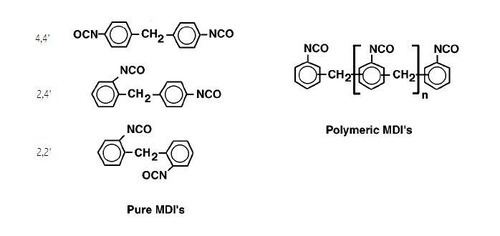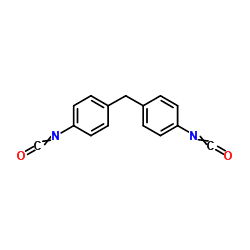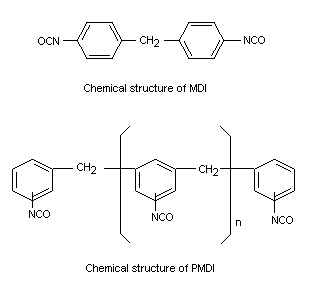Related compounds Formula C15H10N2O2 Melting point 40 °C | Molar mass 250.25 g/mol Density 1.23 g/cm³ Boiling point 314 °C | |
 | ||
Appearance white or pale yellow solid | ||
Methylene diphenyl diisocyanate
Methylene diphenyl diisocyanate, most often abbreviated as MDI, is an aromatic diisocyanate. Three isomers are common, varying by the positions of the isocyanate groups around the rings: 2,2'-MDI, 2,4'-MDI, and 4,4'-MDI. The 4,4' isomer is most widely used, and is also known as 4,4'-Diphenylmethane diisocyanate. This isomer is also known as Pure MDI. MDI reacts with polyols in the manufacture of polyurethane. It is the most produced diisocyanate, accounting for 61.3% of the global market in the year 2000.
Contents
- Methylene diphenyl diisocyanate
- Global methylene diphenyl diisocyanate mdi industry 2016 market research report
- Production
- Reactivity of the isocyanate group
- Applications
- Safety
- References

Global methylene diphenyl diisocyanate mdi industry 2016 market research report
Production

Total world production of MDI and polymeric MDI is over 5 million tonnes per year (Mt/a in 2011). The largest producer is Covestro (ex Bayer MaterialScience) followed closely by Yantai Wanhua. Other major producers are BASF, BorsodChem, Dow, Huntsman, Nippon Polyurethane Industry, OCI. All major producers of MDI are members of the International Isocyanate Institute, whose aim is the promotion of the safe handling of MDI and TDI in the workplace, community and environment.

The first step of the production of MDI is the reaction of aniline and formaldehyde, using hydrochloric acid as a catalyst to produce a diamine precursor under the chemical formulation:
2 C6H5NH2 + CH2O → CH2(C6H4NH2)2 + H2O

Then, these diamines are treated with phosgene to form an MDI. The isomer ratio is determined by the isomeric composition of the diamine. Distillation of the MDI mixture gives polymeric MDI (a mixture of oligomeric polyisocyanates) and an MDI isomer mixture which has a low 2,4' isomer content. Further purification entails fractionation of the MDI isomer mixture.
Reactivity of the isocyanate group
The positions of the isocyanate groups influences their reactivity. In 4,4'-MDI, the two isocyanate groups are equivalent but in 2,4'-MDI the two groups display highly differing reactivities. The group at the 4-position is approximately four times more reactive than the group at the 2-position due to steric hindrance.
Applications
The major application of 4,4'-MDI is the production of rigid polyurethane. Typically, one tonne of polyurethane foam needs 0.616 tonne of MDI and 0.386 tonne of polyol, with 0.054 tonne pentane as a blowing agent. These rigid polyurethane foams are good thermal insulators and used in nearly all freezers and refrigerators worldwide, as well as buildings. Typical polyols used are polyethylene adipate (a polyester) and poly(tetramethylene ether) glycol (a polyether).
4,4'-MDI is also used as an industrial strength adhesive, which is available to end consumers as various high-strength bottled glue preparations.
Safety
MDI is the least hazardous of the commonly available isocyanates but is not benign. Its very low vapour pressure reduces its hazards during handling compared to the other major isocyanates (TDI, HDI). However, it, like the other isocyanates, is an allergen and sensitizer. Persons developing sensitivity to isocyanates may have dangerous systemic reactions to extremely small exposures, including respiratory failure. Handling MDI requires strict engineering controls and personal protective equipment. Compared to other organic cyanates, MDI has a relatively low human toxicity. It is a potentially violently reactive material towards water and other nucleophiles.
